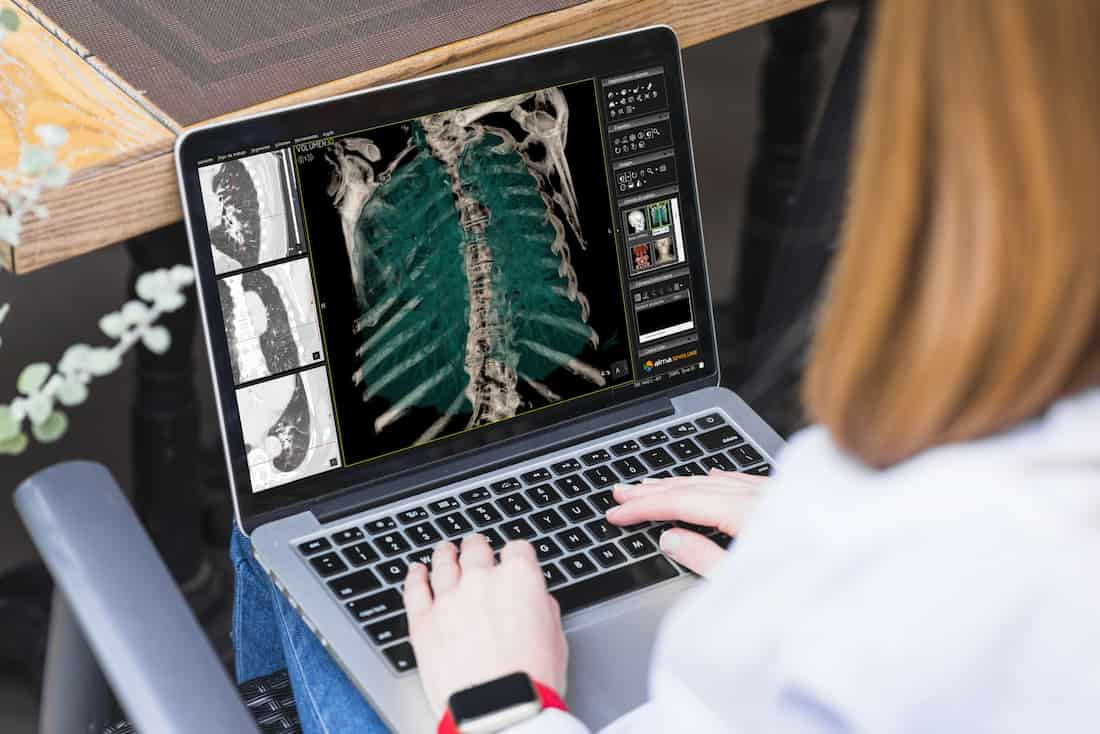There are two key points in teleradiology that have changed the paradigm of how we understand the interpretation of medical test results: the possibility of doing so remotely and asynchronously. Its exponential growth, which accelerated during the COVID-19 pandemic, demonstrated that telemedicine was (and is) a necessity rather than an option.
Its rise responds to real needs: the growing demand for studies, the need for rapid diagnosis and the search for more efficient workflows are some of them.
In Alma Medical We put technology at the service of medicine in an advanced all-in-one solution designed for the storage, viewing, management and sharing of medical images.
Benefits and advantages of teleradiology
Teleradiology offers numerous benefits for healthcare professionals, patients and the healthcare system in general. Some of its main advantages are:
- Accessibility to specialists: A hospital or clinic can obtain the opinion of highly trained radiologists even if they are not locally based. This is particularly useful in rural areas or small centres that do not have certain subspecialists available. Patients obtain accurate interpretations of their studies from experts, which improves the quality of diagnosis in complex diseases. Second opinions can even be requested quickly by sharing studies with experts anywhere in the world.
- Fast diagnoses: Thanks to teleradiology, waiting times for reports are drastically reduced. The doctor can evaluate the images shortly after they are taken, without having to wait days or weeks for a specialist to visit the peripheral centre. This is critical in medical emergencies, where a rapid imaging diagnosis can save lives. The immediacy of the results allows the appropriate treatment to be started sooner.
- 24/7 coverage and continuity of care: Many teleradiology services offer coverage outside normal hours (nights, weekends, or holidays). This means that even if the local radiologist is not on call, another remote professional can take over and interpret urgent studies at any time. This guarantees uninterrupted radiological care, which is particularly beneficial for emergency services.
- Optimisation of medical resources: The distribution of remote radiology work helps alleviate the shortage of radiologists in certain regions. A single specialist can support several centres where the workload would not justify having a full-time radiologist on site. This balances the workload and prevents delays in issuing reports due to staff shortages. For radiologists themselves, this model also offers flexibility, allowing them to work remotely and better balance their schedules.
- Improved patient care: From the patient’s point of view, teleradiology means convenience and speed. It is no longer necessary to travel to large hospitals for a specialist to review their images; the study can be done at a centre close to their home and interpreted by an expert remotely. This reduces travel costs and inconvenience, while the patient receives a report more quickly. Furthermore, when combined with other telemedicine tools, teleradiology allows patients to have a medical consultation where their doctor explains the results via videoconference, without having to physically go to pick up reports. In short, patients receive a faster and safer service, with quality diagnoses, regardless of where they are located.
Integration, connectivity and interoperability: the basis for effective teleradiology
Implementing teleradiology goes beyond sending images from point A to point B: it requires seamless integration into existing clinical workflows. Integration with the healthcare centre’s HIS/RIS/PACS systems is essential to avoid creating information silos. Ideally, the teleradiology platform connects to the RIS/HIS to receive study requests and send the radiology reports back once they have been interpreted, in the same way that a local radiologist would operate.
It must also comply with open interoperability standards such as DICOM (for images) and HL7/FHIR (for clinical information), ensuring that all tools “speak the same language”.
Alma HEALTH PLATFORM has been designed with this philosophy of openness in mind. Thanks to its open architecture, it integrates easily with the centre’s existing systems (HIS, RIS, PACS, etc.), supporting international standards such as HL7, DICOM and FHIR. This means that it can act as a natural extension of the hospital’s IT environment.
For example, a study performed in Radiology is stored in the Alma HEALTH PLATFORM PACS and is automatically available in the web viewer for interpretation; when the report is issued, it can be incorporated into the patient’s history in the HIS, without manual steps or delays. The platform also includes connectors (interoperability engine) to orchestrate data flow with other systems and medical devices.
Another crucial aspect is data security and confidentiality. Teleradiology handles sensitive information that travels over the network, so end-to-end encryption and strict access controls are mandatory. Alma’s solutions comply with data protection regulations (e.g., GDPR in Europe) so that images and diagnoses travel securely and are only accessible by authorised personnel. Integration does not just mean “connecting systems,” but also doing so securely and reliably.
Finally, the ability to develop custom solutions distinguishes a good platform. Each institution has particular needs in terms of workflows, volume of studies, specialities, and resources. Alma understands this and offers a modular and scalable platform that allows for the construction of customised solutions according to the clinical, technical, and organisational needs of each environment. This may involve, for example, customising the report validation workflow, integrating specific AI algorithms chosen by the customer, or adapting the interface for certain user profiles.
The typical process includes an initial technology audit to understand needs, solution design (either cloud-based or on-premises, integrating PACS, RIS, viewers, and necessary AI modules), implementation in the centre’s infrastructure, and even post-implementation support for fine-tuning and assistance. This approach ensures that the technology fits the clinical processes, and not the other way around.
